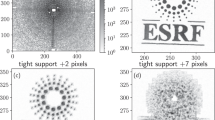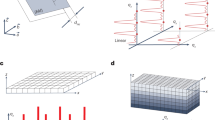Abstract
Arising from K. S. Raines et al. Nature 463, 214–217 (2010)10.1038/nature08705
Raines et al.1 propose a method, which they call ‘ankylography’, for three-dimensional structure determination using single-shot diffractive imaging (SSDI). But the conclusion without limitation that the three-dimensional structure of an object is “in principle encoded into a 2D diffraction pattern on the Ewald sphere” and may be inverted by SSDI is inadequately substantiated and conceptually misleading. Here I point out that SSDI in general suffers from a dimensional deficiency that limits the applicability of ankylography to objects that are small-sized in at least one dimension or that are approximately two-dimensional in some other way.
Similar content being viewed by others
Main
The rate of reliable information transfer via a spatial or temporal channel is fundamentally limited by the channel capacity, which is determined both by the number of degrees of freedom available therein and by the obtainable signal-to-noise ratio2. The resolving powers of telescopes or radio antennas and microscopes including SSDI are all limited in much the same manner. A steep (exponential) price in signal power must be paid to obtain data rates or resolutions significantly beyond those supported by the available number of degrees of freedom2,3. SSDI uses a spatial channel characterized by a linear operator T that projects any real-space amplitude with support  onto the Ewald sphere. It is known2,4 that there exist a pair of orthonormal bases
onto the Ewald sphere. It is known2,4 that there exist a pair of orthonormal bases  and
and  , called normal modes, and also their associated modal gains
, called normal modes, and also their associated modal gains  , all non-negative and arranged in a nondecreasing order such that
, all non-negative and arranged in a nondecreasing order such that  ,
,  . For any predetermined modal cutoff threshold
. For any predetermined modal cutoff threshold  ,
,  is the number of usable normal modes, that is, the number of usable degrees of freedom. It has been rigorously proved5 that
is the number of usable normal modes, that is, the number of usable degrees of freedom. It has been rigorously proved5 that  , which grows more slowly than the number of unknowns
, which grows more slowly than the number of unknowns  in a general three-dimensional object as its size increases. The insufficiency of the number of useable degrees of freedom would persist even if
in a general three-dimensional object as its size increases. The insufficiency of the number of useable degrees of freedom would persist even if  grew exponentially as
grew exponentially as  increased, as long as the exponent grew no faster than
increased, as long as the exponent grew no faster than  : more specifically, so long as
: more specifically, so long as  , for any fixed small
, for any fixed small  .
.
I emphasize the fundamental nature of the limitation: that single-shot diffraction does not convey sufficient information about the three-dimensional structure of an object, even if the amplitude (instead of intensity) of the diffracted field is sampled continuously and measured directly with no phase ambiguity. Given a practically obtainable signal-to-noise ratio and a measurement accuracy that together determine a threshold  of modal cutoff, any signal in a linear space spanned by normal modes of orders higher than
of modal cutoff, any signal in a linear space spanned by normal modes of orders higher than  is essentially lost in transmission or attenuated beyond detection. Oversampling and inversion algorithms are irrelevant in this context.
is essentially lost in transmission or attenuated beyond detection. Oversampling and inversion algorithms are irrelevant in this context.
I note that there has been substantial criticism6,7,8 of ankylography even before its publication1. However, no agreement seems to have been reached on the fundamental problem of dimensional deficiency in ankylography, and an upper bound for the number of degrees of freedom suggested by one critic6 has been disputed and its applicability questioned by Raines et al.1,7,8, whose response demands a mathematically rigorous proof like the one given here. The present analysis also demonstrates the need to quantify noise and a means of doing so, in order to determine a cutoff threshold based on signal-to-noise ratio, which in turn defines the number of useable degrees of freedom. Although Raines et al.1,7,8 discuss degrees of freedom, matrix ranks and data sufficiency, they fail to quantify the noise. To say simply that “Poisson noise was added” to the diffraction patterns does not specify how noise addition was implemented in their numerical simulations, which are the only justification of ‘ankylography’ in the absence of a theoretical base. This vagueness about noise makes it difficult to interpret the reported results and to reconcile the apparent contradiction between the authors’ (ref. 1) and the critic’s (ref. 6) simulation results. Raines et al.1,8 cite “full rank of matrix” and other numerical results to support the claim that a curved surface of detection and oversampling yielded sufficient information for three-dimensional structure inversion, but they have not responded to the critic’s numerical examples and figures showing rapid decays of singular values6.
In summary, SSDI of truly three-dimensional structures does not scale. The applicability of ankylography is limited to objects that are small-sized with respect to the wavelength in at least one dimension or have structures that are essentially two-dimensional in complexity. Such may be the case in the computer tests and preliminary experiment of ref. 1. Raines et al.1 also emphasize certain “physical constraints”, many of which are actually steps of numerical procedures instead of mathematical constraints of model formulation. Incorporating more genuine physical constraints could possibly alleviate the problem of dimensional deficiency. However, that would diminish the generality and appeal of ankylography, and the same feat is arguably achievable by conventional diffractive imaging with a flat image detector.
References
Raines, K. S. et al. Three-dimensional structure determination from a single view. Nature 463, 214–217 (2010)
Gallager, R. G. Information Theory and Reliable Communication (Wiley, 1968)
Hansen, R. C. Fundamental limitations in antennas. Proc. IEEE 69, 170–182 (1981)
Miller, D. A. B. Spatial channels for communicating with waves between volumes. Opt. Lett. 23, 1645–1647 (1998)
Wei, H. Fundamental limits of “ankylography” due to dimensional deficiency. Preprint at http://arXiv.org/abs/1001.4594v1 (2010)
Thibault, P. Feasibility of 3D reconstructions from a single 2D diffraction measurement. Preprint at http://arXiv.org/abs/0909.1643v2 (2010)
Miao, J. Response to “Feasibility of 3D reconstruction from a single 2D diffraction measurement”. Preprint at http://arXiv.org/abs/0909.3500v1 (2009)
Miao, J. & Chen, C.-C. 2nd Response to “Feasibility of 3D reconstruction from a single 2D diffraction measurement”. Preprint at http://arXiv.org/abs/0910.0272v1 (2009)
Landau, H. J. & Widom, H. Eigenvalue distribution of time and frequency limiting. J. Math. Anal. Appl. 77, 469–481 (1980)
Bhatia, R. Perturbation Bounds for Matrix Eigenvalues (SIAM, 2007)
Author information
Authors and Affiliations
Ethics declarations
Competing interests
Competing financial interests: declared none.
Rights and permissions
About this article
Cite this article
Wei, H. Fundamental limits of ‘ankylography’ due to dimensional deficiency. Nature 480, E1 (2011). https://doi.org/10.1038/nature10634
Received:
Accepted:
Published:
Issue Date:
DOI: https://doi.org/10.1038/nature10634
This article is cited by
-
Computed stereo lensless X-ray imaging
Nature Photonics (2019)
-
Sparsity-based Ankylography for Recovering 3D molecular structures from single-shot 2D scattered light intensity
Nature Communications (2015)
-
Investigating the optical nand gate using plasmonic nano-spheres
Optical and Quantum Electronics (2015)
-
Fundamental limits of ‘ankylography’ due to dimensional deficiency
Nature (2011)
-
Three-dimensional technique on trial
Nature (2011)
Comments
By submitting a comment you agree to abide by our Terms and Community Guidelines. If you find something abusive or that does not comply with our terms or guidelines please flag it as inappropriate.




 being a two-dimensional Fourier transform and
being a two-dimensional Fourier transform and  being a linear operator of z integration
being a linear operator of z integration follows from the well-known result
follows from the well-known result , in conjunction with inequalities
, in conjunction with inequalities  , with the second inequality following from an operator inequality
, with the second inequality following from an operator inequality .
.